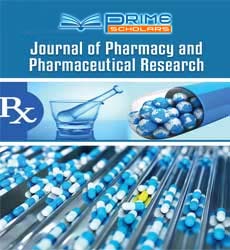Perspective - (2022) Volume 6, Issue 5
Antibody Based Therapeutics is at the Center of Drug Discovery
Claus Salvator*
Department of Pharmacy, University of Perth, Australia
*Correspondence:
Claus Salvator,
Department of Pharmacy, University of Perth,
Australia,
Email:
Received: 03-Oct-2022, Manuscript No. IPIPR-22-14542;
Editor assigned: 05-Oct-2022, Pre QC No. IPIPR-22-14542 (PQ);
Reviewed: 19-Oct-2022, QC No. IPIPR-22-14542 ;
Revised: 24-Oct-2022, Manuscript No. IPIPR-22-14542 (R);
Published:
31-Oct-2022, DOI: 10.21767/IPIPR.22.6.23
Introduction
In humans 5 classes of Abs (interchangeable with immunoglobulins
or Igs). IgG, IgA, IgD, IgE, IgM are secreted as glycoproteins
by activated B cells. All human Igs have a basic monomeric
‘H2L2’ structure consisting of two heavy (H) chains and two light
(L) chains. Each H chain is paired with an L chain. The H chains
define the class of Igs (represented by the Greek letters γ, α, δ,
ε, μ), while the L chains consist of either κ or λ isoforms. Each Ig
has two defined regions. Antigen-binding region (Fab) in the top
half and crystallizable fragment (Fc) in the bottom half. The Fc region
is composed entirely of H chains, whereas the Fab region is
composed of both H and L chain domains. Mouse-derived antibodies
elicited unwanted immune responses in humans. Reduced
effector function in humans also limited Ab potency in mice. In
the last 2-3 decades, various technologies (display technology, humanization,
and transgenic mice) have enabled the generation of
antibody drugs more suitable for the human immune system. Antibody
(Ab)-based therapeutics is therefore at the center of drug
discovery, with antibodies being the fastest growing class of drugs.
Description
Antibody production in the body begins with the expression of
IgM and IgD on the surface of naive B cells in response to antigenic
stimulation. High-affinity IgG is generated through a process of
hyper mutation and class switching. Human IgG is further divided
into IgG1, IgG2, IgG3, and IgG4 isotypes. The Fab domain is composed
of two variable domains and two constant domains, with
the two variable domains forming a variable fragment (Fv). The Fv
provides the Ab’s antigenic specificity and the constant domains
provide the structural framework. Each Fv contains three hyper
variable loops known as complementarity determining regions
(CDRs). In theory, it is the hyper variability of the CDRs that allows
Abs to recognize an unlimited number of antigens.
The smallest antigen-binding fragment that retains the entire antigen-
binding site is the Fv fragment, which consists only of the
variable (V) region. A soluble and flexible amino acid peptide linker
is used to connect the V region with an scFv (single chain fragment
variable) fragment to stabilize the molecule, or a constant (C) domain
is added to the V region to form a Fab fragment (fragment,
antigen binding). scFv and Fab are common fragments that are
readily produced in prokaryotic hosts. Expression of recombinant
monoclonal antibodies is an established production technique
based on cloning a synthetic DNA sequence of the antibody of interest
into an expression vector. These plasmid vectors are then
transiently or stably introduced into expression hosts to produce
recombinant antibodies.
Conclusion
Antibodies have been excellent tools in laboratory research for
many years. MAbs were developed about 25 years ago and have
extended the scope of antibodies to ex vivo diagnosis of a wide
range of diseases. Scientists are increasingly exploiting their high
specificity and selective binding capacity by using them in immunotherapy.
The advent of hybridoma technology has made MAbs
endlessly available. A large number of MAbs generated using this
technique have helped identify and analyze tumor-associated antigens
from several different human melanomas, carcinomas, lymphomas,
and leukemias. The available literature to date reports
over 100 unique MAbs against human cancers. MAbs are produced
using hybridoma technology. This method provides an unlimited
supply of homogeneous antibodies with the desired specificity.
Acknowledgement
The author is grateful to the journal editor and the anonymous
reviewers for their helpful comments and suggestions.
Conflict Of Interest
The author declared no potential conflicts of interest for the research,
authorship, and/or publication of this article.
Citation: Salvator C (2022) Antibody Based Therapeutics is at the Center of Drug Discovery. J Pharm Pharm Res.6:23.
Copyright: © 2022 Salvator C. This is an open-access article distributed under the terms of the Creative Commons Attribution
License, which permits unrestricted use, distribution, and reproduction in any medium, provided the original author and source
are credited.

